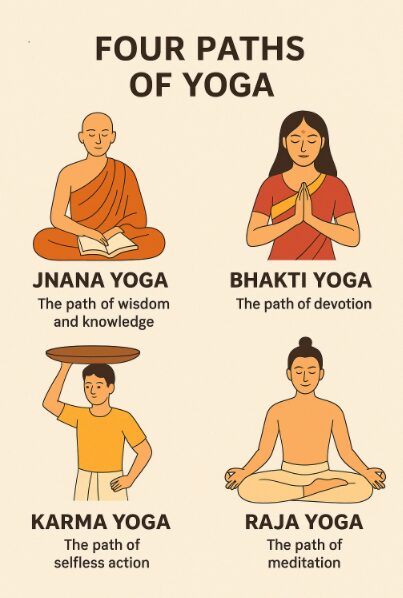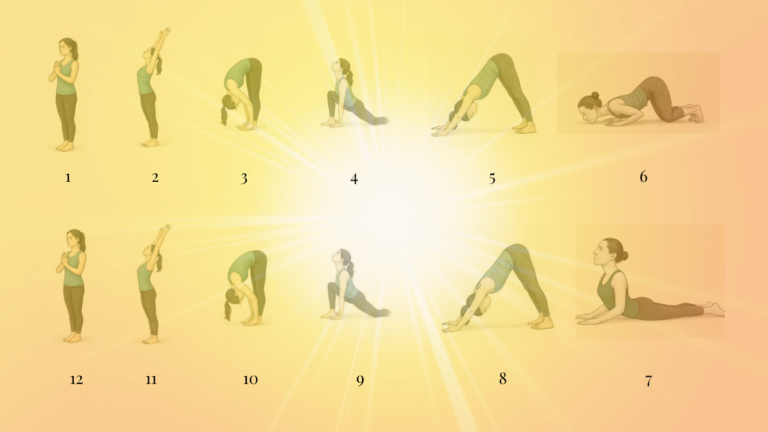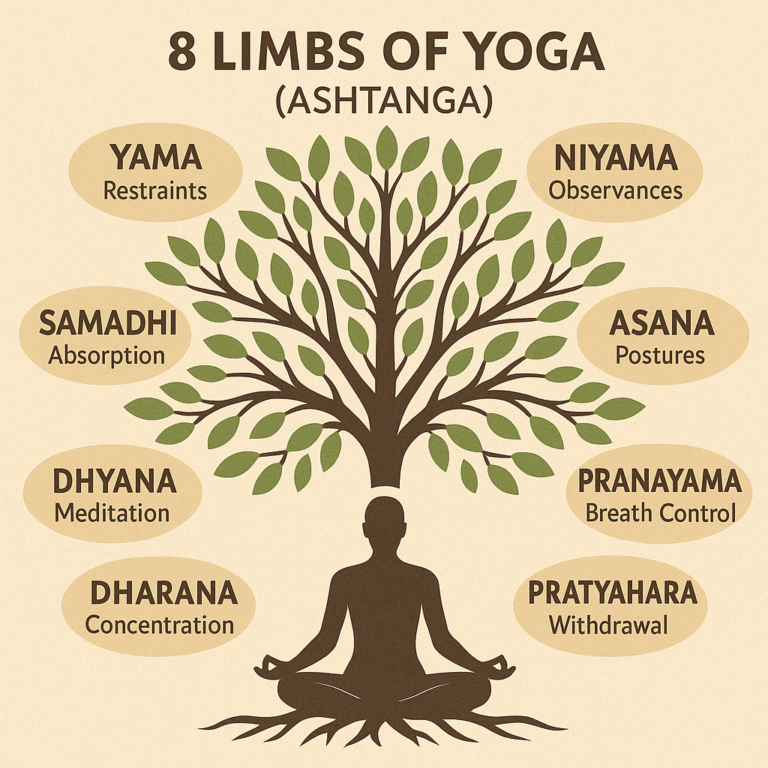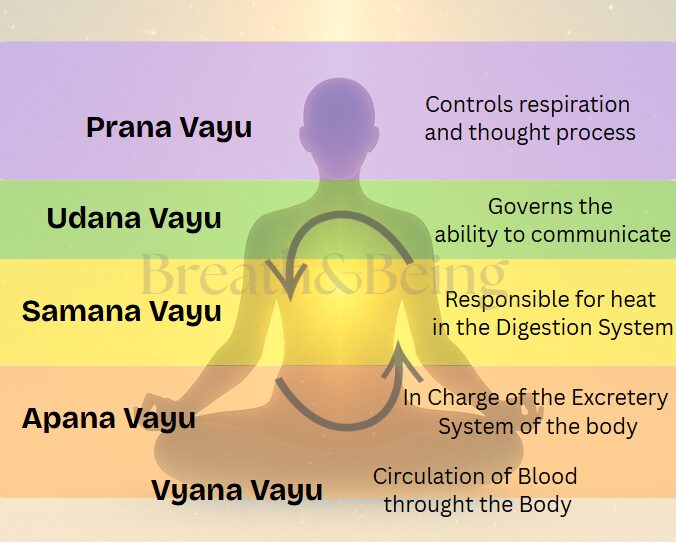The Four Paths of Yoga: A Journey Towards Union and Self-Realization
Yoga, derived from the Sanskrit root yuj, meaning “to unite” is an ancient spiritual discipline from Indian sages, that aims to harmonize the body, mind, and spirit. While the modern world associate yoga primarily with physical postures (asanas), the traditional practice is much broader and deeply rooted in philosophy and self-transformation.
The classical teachings of yoga, as outlined in texts like the Bhagavad Gita, Upanishads, and Patanjali’s Yoga Sutras, describe four main paths—each providing a unique approach to self-realization and liberation (moksha). According to our temperament and life situation one can follow any of the four paths for the ultimate goal of life i.e union with the divine consciousness.

The four primary paths are:
- Karma Yoga – The path of selfless action.
- Bhakti Yoga – The path of devotion and love.
- Jnana Yoga – The path of knowledge and wisdom.
- Raja Yoga – The path of meditation and control of the mind.
Let’s explore each in detail
1. Karma Yoga – The Path of Selfless Action
Karma Yoga focuses on performing one’s duties and actions without attachment to the results. It is about cultivating a spirit of selflessness, where every deed is offered as a service to the divine or for the welfare of others.
The Bhagavad Gita emphasizes Karma Yoga as a way to purify the mind and dissolve ego. Lord Krishna teaches Arjuna that one should act without selfish motives, surrendering the fruits of action to the higher will.
Key Practices:
- Performing daily responsibilities with mindfulness and without expectation of reward.
- Engaging in acts of charity and service (seva).
- Cultivating detachment and equanimity amid success and failure.
- Viewing work as worship, dedicating actions to a higher purpose.
Benefits of Karma Yoga:
- Reduces the ego and selfish desires – Through Karma Yoga, one learns to act without attachment to the outcome (Nishkama Karma). By dedicating every action to the divine or to the greater good, the ego gradually dissolves. This process brings a deep inner freedom and opens the door to non-duality (Advaita), where one perceives the oneness of all beings.
- Brings clarity and peace of mind through selfless service – When we engage in selfless service, our minds shift away from constant self-centered thoughts and worries. By focusing on helping others or performing duties sincerely, mental clutter diminishes, and clarity naturally arises.
Example:
Volunteering at a shelter or helping a colleague without expecting anything in return creates a sense of fulfillment and inner peace that material rewards cannot provide.
- Helps integrate spiritual practice into everyday life – Unlike paths that require withdrawing from society or extensive solitude, Karma Yoga can be practiced in the midst of daily activities. It shows that spiritual growth doesn’t require escaping the world but rather engaging with it in a conscious, selfless way.
Example:
A doctor treating patients with compassion, without being driven solely by profit, turns work into a spiritual practice.
Ideal Practitioners of Karma Yoga
Karma Yoga is especially suited for individuals who:
- Are active and dynamic, with a natural inclination toward work and service.
- Thrive in social environments, interacting with others regularly.
- Feel motivated by community service, humanitarian work, or social causes.
- Prefer to express their spirituality through action rather than contemplation alone.
2. Bhakti Yoga – The Path of Devotion and Love
Bhakti Yoga is rooted in love and surrender to the divine. It is the yoga of the heart, where the practitioner develops a deep, personal relationship with God or the universal consciousness through devotion.
According to the Bhagavad Gita, Bhakti is one of the simplest and most accessible forms of yoga because it relies on love rather than intellectual understanding or rigorous discipline. The goal is to dissolve the ego and merge with the divine through heartfelt devotion.
Key Practices:
- Chanting mantras and devotional songs (kirtan or bhajans).
- Prayer and meditation on the divine name or form.
- Reading sacred texts like the Bhagavad Gita or Ramayana with reverence.
- Surrendering all actions, thoughts, and emotions to the divine will.
Forms of Bhakti
1. Sakhya Bhava – Relating to God as a Friend
In Sakhya Bhava, the devotee approaches God as a close and trusted friend, sharing joys, sorrows, secrets, and experiences as one would with a beloved companion. This relationship is built on trust and equality, rather than fear or reverence. This form of Bhakti allows the practitioner to feel deeply connected to the divine in a natural and heartfelt way, free from formality.
Example:
In the Mahabharata, Arjuna relates to Lord Krishna as his closest friend and confidant. Even though Krishna is the Supreme Being, Arjuna speaks to Him openly, expressing doubts and seeking guidance without hesitation.
Modern Example:
A person who prays by speaking to God conversationally, sharing their daily experiences and challenges, is practicing Sakhya Bhava.
2. Dasya Bhava – Serving God as a Servant
Dasya Bhava represents the attitude of reverence, humility, and obedience, where the devotee sees themselves as a servant of God. In this relationship, the divine is viewed as the ultimate master or ruler, and the devotee’s role is to serve faithfully without ego or expectation.
Example :
Lord Hanuman, the devoted servant of Lord Rama in the Ramayana, perfectly embodies Dasya Bhava. His service to Rama is marked by unwavering loyalty, courage, and humility.
Another example is Lakshmana, who serves Rama tirelessly throughout his life, seeing Rama’s happiness as his own purpose.
Modern Example:
Volunteering at a temple, engaging in community service, or dedicating one’s profession to the welfare of others while offering the results to God reflects Dasya Bhava.
3. Vatsalya Bhava – Loving God as a Parent Loves a Child
In Vatsalya Bhava, the devotee relates to the divine as a caring parent, expressing love through nurturing, protection, and affection. Here, the roles are reversed: instead of seeing God as a caretaker, the devotee takes on the role of protector and caregiver, showering the divine with tender, parental love.
This relationship is characterized by deep intimacy, responsibility, and unconditional care, much like the bond between a mother or father and their child.
Example:
Yashoda, the foster mother of Krishna, embodies this bhava perfectly. She scolds Krishna for mischief, feeds Him, and even fears for His safety, treating the Supreme Being as her little boy.
Modern Example:
A person might set up a small altar at home and care for the deity as they would a beloved child—bathing the image, offering food, dressing it, and singing lullabies as a form of devotion.
4. Madhurya Bhava – Loving God as a Beloved
Madhurya Bhava is the highest and most intimate form of Bhakti, where the devotee relates to God as their beloved or lover. This relationship transcends ordinary romantic love, representing the soul’s intense longing to unite completely with the divine.
It is characterized by passion, surrender, and ecstatic devotion, reflecting the deepest emotional connection possible between the devotee and the divine.
Example
The Gopis of Vrindavan, especially Radha, exemplify Madhurya Bhava. Their love for Krishna is pure, unconditional, and filled with yearning.
Similarly, the poet-saint Mirabai expressed this form of Bhakti through her songs of divine love for Krishna.
This type of Bhava burns away all traces of ego, as love becomes total and absolute – generating profound joy, ecstasy, and spiritual fulfillment.
Modern Example:
A person singing devotional songs or writing poetry to express their deep yearning for divine union is a great example of the practice of Madhurya Bhava.
Benefits of Bhakti Yoga
- Cultivates Inner Peace and Joy – When a practitioner surrenders their worries, desires, and actions to the divine, they are no longer burdened by fear or anxiety. This surrender brings emotional stability and inner contentment. Unlike material happiness, which is temporary and dependent on external circumstances, the joy cultivated through Bhakti Yoga is self-sustaining and unconditional. It flows from the connection with something eternal and infinite.
Example:
A person singing devotional hymns or chanting mantras experiences a profound sense of calm and bliss, even amid life’s challenges.
- Helps Overcome Negative Emotions Through Love and Surrender – Human beings often struggle with negative emotions such as anger, jealousy, greed, guilt, or resentment. Bhakti Yoga transforms these emotions by redirecting them into devotion and love. Through surrender, the practitioner acknowledges that they are not in ultimate control of life. This acceptance dissolves inner resistance and conflict. Instead of suppressing emotions, Bhakti Yoga channels them into a higher purpose—whether through prayer, music, or acts of service.
- Simplifies Spiritual Practice Through Heartfelt Devotion – Some spiritual paths, such as Jnana Yoga (the path of knowledge), require rigorous intellectual study and contemplation. Others, like Raja Yoga, demand strict mental discipline and advancedmeditation techniques. Bhakti Yoga, however, is accessible to anyone, regardless of education or lifestyle.
Ideal Practitioners of Bhakti Yoga
Bhakti Yoga is particularly suited for those who:
- Are emotional and expressive, naturally guided by feelings.
- Possess artistic talents, such as music, poetry, dance, or painting, which can be used as expressions of devotion.
- Have a strong faith in a higher power and a desire to form a personal connection with the divine.
- Seek a heart-centered practice rather than purely intellectual or disciplined approaches.
3. Jnana Yoga – The Path of Knowledge and Wisdom
Jnana Yoga is considered the most challenging path, as it requires deep contemplation and intellectual inquiry. It involves discriminating between the real and the unreal (viveka), ultimately leading to the realization that the true Self is beyond the body and mind.
The process involves moving from intellectual understanding to direct spiritual experience. The main practices can be summarized in four key steps: Shravana, Manana, Nididhyasana, and Self-Inquiry.
These steps are sequential but also interconnected, guiding the practitioner from hearing spiritual truths to fully embodying them.
- Shravana – Shravana (from the Sanskrit root shru, “to hear”) is the initial stage of spiritual learning, where the seeker listens to teachings from sacred texts and enlightened teachers (gurus). The goal here is to gain clarity about the ultimate truth by exposing oneself to authentic spiritual knowledge. This stage plants the seeds of wisdom in the mind, forming the foundation for deeper contemplation.
How to Practice Shravana
- Attend spiritual discourses, satsangs (gatherings), or listen to recorded teachings.
- Read scriptures or philosophical texts with reverence and focus.
- Approach the studies with a beginner’s mind—free from preconceived notions or skepticism.
Example – Reading Upanishads, Bhagwat Gita or the discourses from the saints with deep attention and understanding.
2. Manana – Once spiritual truths are heard, they must be reflected upon deeply. Manana involves logical reasoning and contemplation to internalize the teachings, test them against personal experience, and remove doubts. This stage transforms theoretical knowledge into personal conviction. Without Manana, even profound teachings remain superficial and easily forgotten.
How to Practice Manana
- Set aside quiet time for contemplation after study or satsang.
- Use journaling to write down insights, questions, and reflections.
- Engage in spiritual dialogue with fellow seekers to refine understanding.
- Observe thoughts and feelings that arise, examining whether they align with the teaching.
3. Nididhyasana – Meditating and Integrating the Wisdom into Direct Experience Nididhyasana is deep meditation on the truths understood during Shravana and Manana. This stage moves beyond intellectual contemplation into direct inner realization. Here, the practitioner sits in stillness, focusing on the essence of the teachings until they merge with their very being, experiencing the truth directly rather than merely knowing it intellectually.
How to Practice Nididhyasana
- Sit in a quiet, distraction-free place, maintaining a comfortable meditative posture.
- Focus on a single truth or mantra, such as: “Aham Brahmasmi” — “I am Brahman.”
- As thoughts arise, gently return focus to the core truth without struggle.
- Allow the mind to become completely absorbed, dissolving into pure awareness.
Example:
A practitioner meditates daily on the realization that they are not the body or mind, but the eternal, unchanging consciousness. Over time, this understanding becomes a lived experience, not just a concept.
4. Self-Inquiry – Asking “Who Am I?” – Self-inquiry (Atma Vichara), popularized by the sage Ramana Maharshi, is a direct method for realizing the true Self. It involves questioning the very sense of “I” that we identify with, gradually peeling away layers of illusion. Instead of focusing on external teachings or rituals, the practitioner turns inward, continuously asking: “Who am I?” The goal is not to answer intellectually, but to trace the source of the “I-thought”, leading to direct awareness of the eternal, changeless Self.
Benefits of Jnana Yoga:
- Brings profound clarity and understanding of life and existence.
- Dissolves ignorance, the root cause of suffering.
- Leads to liberation through direct realization of the Self.
Ideal practitioners of Jnana Yoga :
Jnana yoga is suitable for those who are
- Philosophical thinkers
- Seekers of truth
- Intellectually driven
4. Raja Yoga – The Path of Meditation and Self-Mastery
Raja Yoga, often called the “royal path” focuses on controlling the mind through meditation and disciplined practices. It is closely associated with Patanjali’s Yoga Sutras, which outline the eight-limbed path (Ashtanga Yoga).
The central aim of Raja Yoga is to achieve mental stillness and self-realization by transcending thoughts and emotions. It integrates physical, ethical, and spiritual practices.
The Eight Limbs of Raja Yoga:
- Yama – moral restraints (e.g., non-violence, truthfulness).
- Niyama – personal observances (e.g., purity, contentment).
- Asana – physical postures to prepare the body for meditation.
- Pranayama – breath control to regulate energy.
- Pratyahara – withdrawal of the senses from external distractions.
- Dharana – concentration on a single point or object.
- Dhyana – meditation leading to inner stillness.
- Samadhi – union with the divine or pure consciousness.
Benefits of Raja Yoga:
- Develops focus, clarity, and inner peace.
- Strengthens the body and nervous system through asanas and pranayama.
- Offers a structured path to spiritual awakening.
- Reduces stress and anxiety through deep meditation.
Ideal for:
Individuals who are disciplined, contemplative, and seek systematic spiritual growth.
Integrating the Four Paths
While each path is distinct, they are complementary rather than exclusive. In practice, most people naturally combine elements of multiple paths:
- A Karma Yogi may also practice meditation (Raja Yoga).
- A Bhakti Yogi may engage in self-inquiry (Jnana Yoga).
- A Jnana Yogi may perform service as a form of detachment (Karma Yoga).
Swami Vivekananda emphasized this integration, suggesting that a balanced spiritual life incorporates action, devotion, knowledge, and meditation.
Conclusion
The four paths of yoga—Karma, Bhakti, Jnana, and Raja—offer different yet interconnected approaches to spiritual awakening. Whether through service, love, wisdom, or meditation, each path guides the seeker toward the same destination: inner freedom and unity with the divine.
Choosing the right path depends on one’s temperament, circumstances, and natural inclinations. Ultimately, yoga is not just a practice but a way of life, guiding us toward harmony, self-realization, and lasting peace.






One Comment